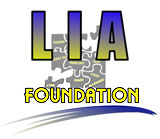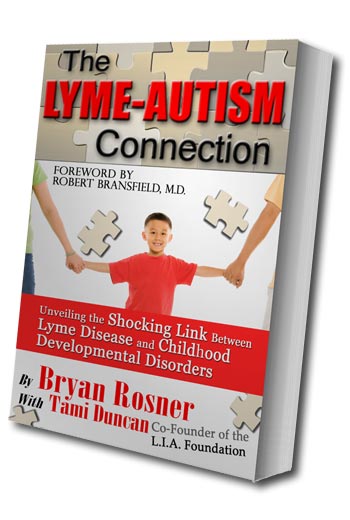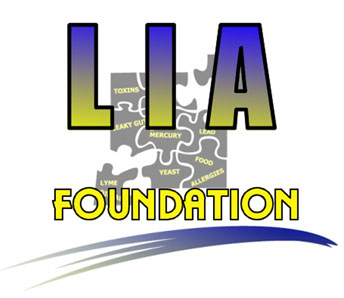|
Now Available!
Published July 1, 2008.
|
287 Pages - $25.95
Ordering Options |
|
Order
Online

Order
by Phone
(530) 541-7200 |
Written in collaboration
with LIA Foundation

Meet
the Authors...

Bryan Rosner
Author, Health Care Journalist
Read Bryan's Preface

Tami Duncan
Contributing Writer
Co-Founder, LIA
Foundation
Read
Tami's Preface
Book
Excerpts:
Tami's Preface
Bryan's Preface
Symptoms vs.
Syndromes
Medical
Hypothesis Article
Robert Bransfield,
M.D.
Enlarged Cover
Index (allow
time to load)
|
|
|

287 Pages, $25.95, Paperback
Enlarged Cover • Order
Now
|
287 Pages - $25.95
Ordering Options |
|
Order
Online

Order
by Phone
(530) 541-7200 |
|
 Back
to overview page
Back
to overview page
Bryan Rosner's Preface
Some authors have a clinical, sterile, impersonal relationship with the content they write. My relationship with this book is quite the opposite. As an author, my personal experience with both Lyme disease and autism has been the driving force behind my desire to write this book. When I (Bryan) was about 23 years old, I had a friend who worked with autistic children at a middle school in the city where I grew up. I would visit her during the workday, and I had a lot of contact with the autistic children.
Around the same time, I was diagnosed with Lyme disease. As time passed and I began to intensively study the disease, I became more and more intrigued by the autistic children at the middle school. Something told me—some underlying, gut instinct—that somehow, some way, these children had a disease similar to what I was suffering from. I had no way of proving this hunch. It just seemed that they were feeling what I was feeling.
Eventually, I lost contact with the autistic children of that local middle school. In the years that passed after my time with them, I would occasionally encounter a desperate mother of an autistic child, be her a family friend, distant relative, or just an acquaintance. The nagging instinct that I was somehow connected to these children would surface again for a few days, during which time I would ponder a possible Lyme-autism connection. This was back in approximately 2001, before I had heard about the connection. So, my initial thoughts on the topic were not sparked by a newspaper article or website, but were instead much more personal—a gut level, instinctual feeling.
In 2006, working as a professional healthcare journalist, I became acquainted with Tami Duncan, co-founder of the LIA Foundation. My forgotten experiences with autistic children and gut feeling about a possible connection between Lyme disease and autism dramatically resurfaced as I began to
communicate with Tami. Sure enough, it appeared there actually was such a connection, even to the extent that annual
conferences on the subject were taking place, bringing together some of the most credible and well-respected physicians in the Lyme and autism fields.
Although various articles and statements of hypotheses on the connection had been written, there was not a book on the topic. So, I undertook the project with Tami. As I embarked down the road of the hundreds of hours of research necessary for the book, I learned that the Lyme-autism connection was indeed much more than a hunch. It became obvious that this connection is supported by a great deal of science and the personal experiences of hundreds of mothers with autistic children. As I wrote the book and collaborated closely with Tami, I found that the central ideas and concepts were so fascinating and important that they practically leapt out of the research materials. This book needed to be written so badly that it practically wrote itself.
Looking back, I now realize that I have probably had Lyme disease since birth. I had experienced strange symptoms as a baby, and on into childhood (according to my parents). I spent the first 3 days of my life in intensive care, with a fever, apart from my mother and father. During my early teenage years, I always had aches, pains, migraine headaches, food intolerances, severe allergies, and mood swings. I just assumed that these symptoms were normal—“growing pains,” my doctors said. When these same symptoms became debilitating in my early twenties, I knew they were not normal. They turned out to be a raging case of Lyme disease. They improved only after antibacterial treatment.
Perhaps, under slightly different circumstances, I myself may have ended up with autism. My symptoms began at birth. What really separated me from autistic children? Maybe a lot less than I would like to believe. After researching the Lyme-autism connection for months, I now believe that I was much closer to acquiring a severe developmental disorder than I had ever guessed or imagined.
As I write this, I am now a new father. I have a healthy, thriving 9-month old son. So far, he appears to be completely free of the health problems which changed the course of his father’s life. However, I cannot count the number of nights I lost sleep during my wife’s pregnancy, hoping and praying that my unborn child would be healthy. Although my wife is healthy and Lyme-free, recent research has shown that Lyme disease can be transmitted sexually, and also from mother to child during pregnancy. Did I give my wife a subclinical Lyme disease infection which might have been passed to my unborn child? So far, it appears we are in the clear. Yet, the potential guilt and dread of knowing I might have been responsible for adversely affecting both my wife and my child, has never escaped me.
Because of the current research being published, we have not vaccinated our son yet, and we are not sure whether or not we will vaccinate him in the future. I believe that some vaccines are dangerous enough without Lyme disease in the family history. When you add Lyme disease to the mix, the situation becomes even more precarious. It is now believed that Lyme disease and childhood vaccinations can act synergistically to create mayhem in the body. While one or the other may be merely dangerous, when combined, the two factors can become devastating.
Today, I am optimistic. Modern research and awareness is opening the doors to new treatments, effective prevention programs, and a deeper understanding of the complex web that is Lyme disease and autism. The dark ages are giving way to a new era which will bring health and hope to thousands of families.
Join me in the fight to uproot and expose objective scientific truth, whatever that truth may be. Whether they be financial interests, political agendas, or simply the slow turning of the wheel of medical progress, together we can conquer all of the obstacles in the way of our children’s health. Human progress is dependent upon health, and health, I believe, is dependent upon honest, direct, and revealing journalism. The urgency of the situation, my passion for uncovering and exploring this connection, and the expertise brought to the table by those who contributed to this project, have culminated in a book which I hope you find as fascinating as I do.
|
|
Written, produced, and sold
in collaboration with
The LIA Foundation
 |
Now Available! Published
July 1, 2008
THE LYME-AUTISM
CONNECTION
By Bryan Rosner
With Tami Duncan
Foreword by Robert Bransfield, M.D.
Paperback Book, 287 Pages, $25.95 |
|
Ordering Options: |
|
|
Order By Phone:
(530) 541-7200
|
Order Online:

|
|
